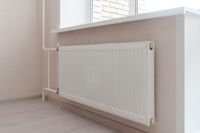What's the Difference Between Hydronic & Convection Heaters?
By Total Tech

Many homeowners invest in electric baseboard heaters to supplement their HVAC systems in winter. There are two types of baseboard heaters: hydronic and convection. While they both provide additional heat flow to a room, they each do so differently. If you’re looking for a secondary source of heat, consider the pros and cons of both convection and hydronic heating.
Convection vs. Hydronic Heating
Convection Heaters
Convection heating is the most basic and common form of baseboard heater installed. It consists of electric coils that heat up and expel warm air, and the temperature is controlled by a thermostat.
 Convection heaters tend to be the most inexpensive type, and they are long-lasting and available in more sizes and designs. However, they are the least energy-efficient type of heater, and the room quickly loses warmth when the system cools down.
Convection heaters tend to be the most inexpensive type, and they are long-lasting and available in more sizes and designs. However, they are the least energy-efficient type of heater, and the room quickly loses warmth when the system cools down.
Hydronic Heating
While these heaters are also powered by electricity, they rely on water or heating oil to heat the air, which allows the spaces they’re heating to retain more heat for longer periods. While more energy efficient, hydronic heaters are more expensive to purchase, but the energy savings over the years help offset the upfront costs. They are available in freestanding or built-in systems, which can be complicated to install. All hydronic heating systems are quiet, low maintenance, and reliable.
Homeowners in Lewisburg, WV, interested in learning more about baseboard heaters can find expert advice from Total Tech. Their heating professionals have a combined 30 years of experience. Specializing in hydronic heating, they can install a variety of heating systems, including geothermal systems, furnaces, radiators, and heat pumps. They also offer service agreements on all brands of heating and air conditioning equipment. Call (304) 645-4444 to request a free in-home estimate, or visit them online to learn more about their services.
About the Business
Have a question? Ask the experts!
Send your question

